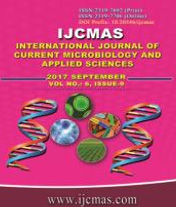


 National Academy of Agricultural Sciences (NAAS)
National Academy of Agricultural Sciences (NAAS)

|
PRINT ISSN : 2319-7692
Online ISSN : 2319-7706 Issues : 12 per year Publisher : Excellent Publishers Email : editorijcmas@gmail.com / submit@ijcmas.com Editor-in-chief: Dr.M.Prakash Index Copernicus ICV 2018: 95.39 NAAS RATING 2020: 5.38 |
The control of gaseous exchange between the leaf and bulk atmosphere by stomata governs CO2 uptake for photosynthesis and transpiration, determining plant productivity and water use efï¬Âciency. The balance between these two processes depends on stomatal responses to environmental and internal cues and the synchrony of stomatal behavior relative to mesophyll demands for CO2. Stomatal conductance (Gs) is an important trait responsible for the genotypic difference in gas diffusion for photosynthesis and transpiration in guava (Psidium guajava L.). Correlation studies among different horticultural traits indicated that leaf stomatal density was positively correlated with stomatal conductance (Gs), to net photosynthesis rate (Pn, 0.110), and leaf net CO2 assimilation rate (An, 0.177) (Table 1).Similarly, number of stomata is negatively correlated with Transpiration (E, 0.193). Further our results indicated that there is highly significant positive correlation among net photosynthesis rate, transpiration rate, stomatal conductance and internal CO2 concentration (Ci).The differences in leaf stomatal numbers and gas exchange values that existed among the genotypes can be taken into consideration as selection criteria for guava to be grown in regions with varying environmental conditions. These findings also add new insights into the correlations among traits involving carbon and water economy in guava.
 |
 |
 |
 |
 |